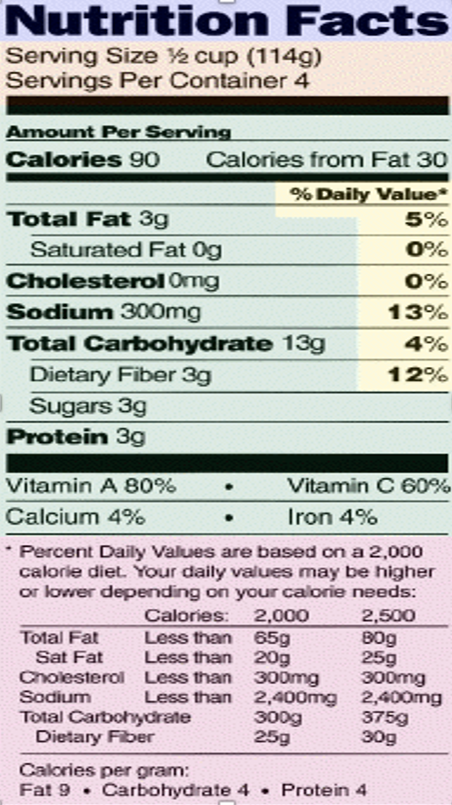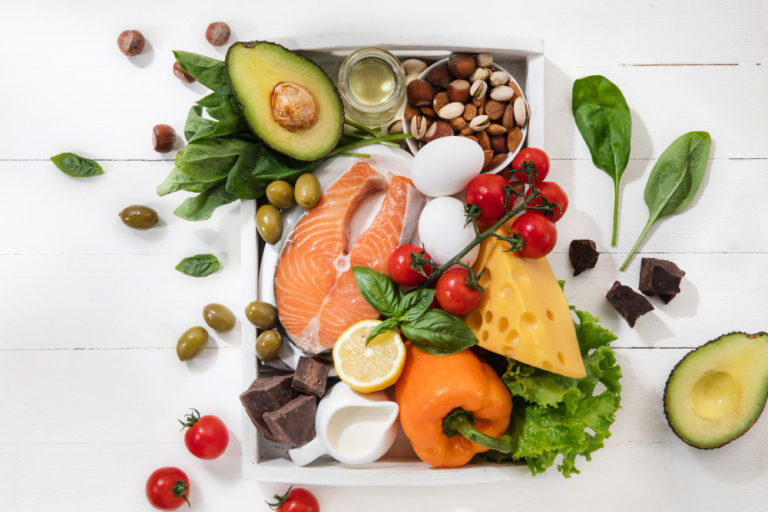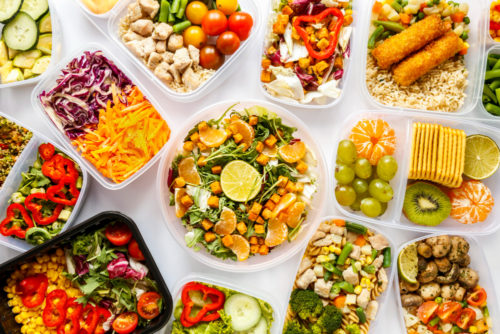Understanding The Food Label And The Nutrition Information - An Overview
Understanding Food Labels & the nutritional information is a big part of making the right choices in your DIYFIT Nutrition Program.
The information in the main or top section of the food label, can vary with each food product; it contains product-specific information (serving size, calories, and nutrient information).
The bottom part contains a footnote with Daily Values (DVs) for 2,000 and 2,500 calorie diets.
This footnote provides recommended dietary information for important nutrients, including fats, sodium and fiber. The footnote is found only on larger packages and does not change from product to product.

First Understanding The Food Labels Serving Size:
The first place to start when you look at the Nutrition Facts label is the serving size and the number of servings in the package. Serving sizes are standardized to make it easier to compare similar foods; they are provided in familiar units, such as cups or pieces, followed by the metric amount, e.g., the number of grams. The size of the serving on the food package influences the number of calories and all the nutrient amounts listed on the top part of the label.
Pay attention to the serving size, especially how many servings there are in the food package. Then ask yourself, “How many servings am I consuming”? (e.g., 1/2 serving, 1 serving, or more) In the sample label, one serving equals one-half cup. If you ate the whole package, you would eat one cups. That doubles the calories and other nutrient numbers, including the %Daily Values as shown in the sample label.
Understanding The Food Labels Calories Section:
Calories provide a measure of how much energy you get from a serving of this food. Many Americans consume more calories than they need without meeting recommended intakes for a number of nutrients. The calorie section of the label can help you manage your weight (i.e., gain, lose, or maintain.) Remember: the number of servings you consume determines the number of calories you actually eat (your portion amount).
For example, there are 90 calories in one serving. How many calories from fat are there in ONE serving? Answer: 30 calories, which means almost one-third the calories in a single serving come from fat. What if you ate the whole package content? Then, you would consume two servings, or 180 calories, and 60 would come from fat.
General Guide to Calories
- *40 Calories is low
- *100 Calories is moderate
- *400 Calories or more is high
The General Guide to Calories provides a general reference for calories when you look at a Nutrition Facts label. This guide is based on a 2,000 calorie diet.
Eating too many calories per day is linked to overweight and obesity.

Second Understanding The Food Labels Section, The Nutrients:
The top of the nutrient section in the sample label shows you some key nutrients that impact on your health and separates them into two main groups:
Limit These Nutrients
The nutrients listed first are the ones Americans generally eat in adequate amounts, or even too much. Eating too much fat, saturated fat, trans fat, cholesterol, or sodium may increase your risk of certain chronic diseases, like heart disease, some cancers, or high blood pressure.
Important: Health experts recommend that you keep your intake of saturated fat, trans fat and cholesterol as low as possible as part of a nutritionally balanced diet.
Get Enough of These
Most Americans don’t get enough dietary fiber, vitamin A, vitamin C, calcium, and iron in their diets. Eating enough of these nutrients can improve your health and help reduce the risk of some diseases and conditions. For example, getting enough calcium may reduce the risk of osteoporosis, a condition that results in brittle bones as one ages. Eating a diet high in dietary fiber promotes healthy bowel function. Additionally, a diet rich in fruits, vegetables, and grain products that contain dietary fiber, particularly soluble fiber, and low in saturated fat and cholesterol may reduce the risk of heart disease.
Remember: You can use the Nutrition Facts label not only to help limit those nutrients you want to cut back on but also to increase those nutrients you need to consume in greater amounts.
Understanding Food Labels, Percent Daily Value (%DV):
The % Daily Values (%DVs) is based on the Daily Value recommendations for key nutrients but only for a 2,000 calorie daily diet–not 2,500 calories. You, like most people, may not know how many calories you consume in a day. But you can still use the %DV as a frame of reference whether or not you consume more or less than 2,000 calories. The %DV helps you determine if a serving of food is high or low in a nutrient. Note: a few nutrients, like trans fat, do not have a %DV.
Do you need to know how to calculate percentages to use the %DV? No, the label (the %DV) does the math for you. It helps you interpret the numbers (grams and milligrams) by putting them all on the same scale for the day (0-100%DV). The %DV column doesn’t add up vertically to 100%. Instead each nutrient is based on 100% of the daily requirements for that nutrient (for a 2,000 calorie diet). This way you can tell high from low and know which nutrients contribute a lot, or a little, to your daily recommended allowance (upper or lower).
The Food Labels Quick Guide to %DV:
5%DV or less is low and 20%DV or more is high
This guide tells you that 5%DV or less is low for all nutrients, those you want to limit (e.g., fat, saturated fat, cholesterol, and sodium), or for those that you want to consume in greater amounts (fiber, calcium, etc). As the Quick Guide shows, 20%DV or more is high for all nutrients.
Example: If the amount of Total Fat in one serving listed is 18%DV, is that contributing a lot or a little to your fat limit of 100% DV? Check the Quick Guide to %DV. 18%DV, which is below 20%DV, is not yet high, but what if you ate two servings? You would double that amount, eating 36% of your daily allowance for Total Fat. Coming from just one food, that amount leaves you with 64% of your fat allowance (100%-36%=64%) for all of the other foods you eat that day, snacks and drinks included.
Using the %DV for:
Comparisons: The %DV also makes it easy for you to make comparisons. You can compare one product or brand to a similar product. Just make sure the serving sizes are similar, especially the weight (e.g. gram, milligram, ounces) of each product. It’s easy to see which foods are higher or lower in nutrients because the serving sizes are generally consistent for similar types of foods, except in a few cases like cereals.
Nutrient Content Claims: Use the %DV to help you quickly distinguish one claim from another, such as “reduced fat” vs. “light” or “nonfat.” Just compare the %DVs for Total Fat in each food product to see which one is higher or lower in that nutrient–there is no need to memorize definitions. This works when comparing all nutrient content claims, e.g., less, light, low, free, more, high, etc.
Dietary Trade-Offs: You can use the %DV to help you make dietary trade-offs with other foods throughout the day. You don’t have to give up a favorite food to eat a healthy diet. When a food you like is high in fat, balance it with foods that are low in fat at other times of the day. Also, pay attention to how much you eat so that the total amount of fat for the day stays below 100%DV.
Nutrients Without a %DV: Trans Fats, Protein, and Sugars:
Note that Trans fat, Sugars and, Protein do not list a %DV on the Nutrition Facts label.
Trans Fat: Experts could not provide a reference value for trans fat nor any other information that FDA believes is sufficient to establish a Daily Value or %DV. Scientific reports link trans fat (and saturated fat) with raising blood LDL (“bad”) cholesterol levels, both of which increase your risk of coronary heart disease, a leading cause of death in the US.
Important: Health experts recommend that you keep your intake of saturated fat, trans fat and cholesterol as low as possible as part of a nutritionally balanced diet.
Protein: A %DV is required to be listed if a claim is made for protein, such as “high in protein”. Otherwise, unless the food is meant for use by infants and children under 4 years old, none is needed. Current scientific evidence indicates that protein intake is not a public health concern for adults and children over 4 years of age.
Sugars: No daily reference value has been established for sugars because no recommendations have been made for the total amount to eat in a day. Keep in mind, the sugars listed on the Nutrition Facts label include naturally occurring sugars (like those in fruit and milk) as well as those added to a food or drink. Check the ingredient list for specifics on added sugars.
You may also refer to the National Institute of Health Office of Dietary Supplements for more information.

Finally Understanding Food Lables and the Ingredients List
Ingredients are usually listed below or to the side of the food label, depending upon the packaging. Be sure to read through the ingredients to stay informed of what you’re consuming; this is where you need to be on the lookout for ingredients such as hidden sugars (sugar aliases noted on “THE PURGE”) or harmful fats (also referenced on “THE PURGE”).
